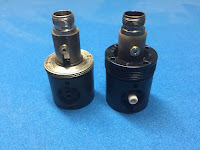Starting with Maglite's founding in 1979 and up until 2015 Mag Instrument supported third party service centers in almost every state. This was the norm when aluminum flashlights first appeared in the early 70s. A 2D Maglite has been consistently priced at around $26. This is equal to almost almost $100 in 2017 dollars so in the early 80s most users considered these lights a sizable investment that they wanted to keep in good running order.
Maglites have always had a lifetime warranty and very rarely are they prone to failure. Mag Instrument has never covered battery leakage though and that is where most faults occur. The switch mechanism occasionally wears and fails or the seals fail and moisture is introduced to the mechanism which results in a high resistance where the bulb will fail to light. I have a post about repairing and diagnosing switches because they can be easily fixed rather than replaced with a little know how. Lenses, switch seals, reflectors and o-rings could also be tuned up on a routine service visit.
During Mag's early days Don Keller mostly went on the road to setup these service centers. Originally Maglite took some of their larger dealers, mainly hardware, sporting goods, and police equipment stores, at about one per state with the exception of Alaska and Hawaii, and trained designated employees on how to service Maglites. The service center was also able to purchase service kits as shown below. (The Maglite is for display only. It's a 1984 3D light I'm working on restoring for another Maglite fan.) Warranty repairs were reimbursed by Maglite at an appropriate rate and normal wear and tear like o-rings and lenses were billed out as per the price list below plus whatever markup the dealer desired. 20% as noted in this case.
This service kit came from a closed Maglite service center. The paperwork with it has the pre-1984 Maglite logo which means it was from one of the earliest service centers setup by Maglite. This particular service kit came from a closed gun dealer / gun smith in Missouri. Most of the items listed on the supply sheet are present as shown below but it has no lenses which gives some insight as to which parts wear first. It does have extra of almost every other item including switches, which is mainly what I was after. These switches are the older style aluminum retaining ring ones. I've discussed the drawbacks of these switches in my post on restorations but I still like to use them for restorations to keep the light period correct. Also shown below is a scan of the small service manual that was included with these kits intended as a reference for the training that was provided.
Included in this kit is also the older style Maglite spanner tool. This tool is far superior to the current plastic one. Most retaining rings come out fairly easily and can even be removed with needle nose pliers as a makeshift spanner but some of the more stubborn ones cause the dowels in the plastic tool to yield the plastic they are housed in and fall out. As far as I know these older aluminum style spanner wrenches are long out of production. the original part # was MSLC-52 but Mag Instrument no longer uses this numbering scheme. The part number for the new spanner wrench is 112-000-001 and is still available for order. Shown below is the new spanner tool vs. the old machined aluminum one.
The tools are pretty neat in that it has a C cell wrench on one end and a D cell wrench on the other. The picture on the left above shows the D cell end and the picture on the right shows the C cell end.
I also have another, newer style, service kit from a now defunct distributor in California. This service kit is from 1995 as noted in the literature that came with it. It comes with parts for both the letter serial (panther), and non-letter serial lights and the maintenance manual notes the differences as well. It is mostly complete and the Maglite part number can even be seen on the side of the box. The manual has instructions in several different languages but I only scanned the English version.
In 2015, during the last year of operation, Maglite had 60 service centers across the US. At the time of posting the service center locator feature could still be found on Mag Instrument's website, as shown below, although no service centers are listed. It's a shame these closed because now all lights must be sent back to Mag Instrument with the postage paid by the owner at least for the delivery to Maglite. This makes most repairs cost prohibitive as a new light can be purchased for around the same cost as shipping.
It is a shame that Maglite closed their service centers. Although, I'm sure they were a losing proposition. Failures are pretty uncommon and at the end of the day with rising competition from cheap, plentiful, imported LED lights there's no way Maglite could operate these service centers and sell a reasonably priced light. Unfortunately it's a bygone era and for the majority of people flashlights are now a disposable commodity.
As always I'm looking to buy Vari-Beams and Vintage/Rare Mags. Please let me know if you have any, top dollar paid.
















.jpg)




































